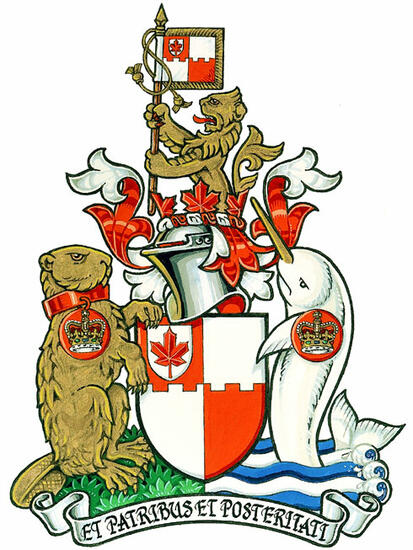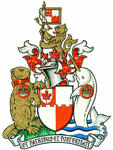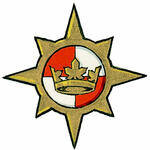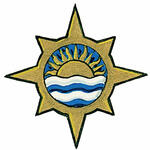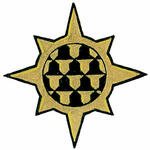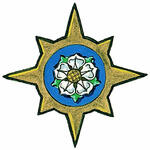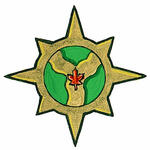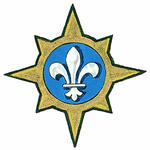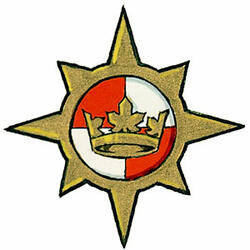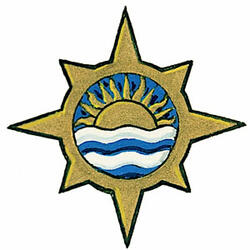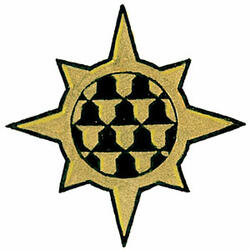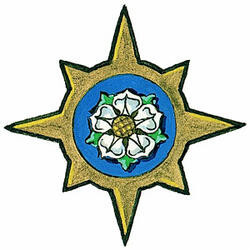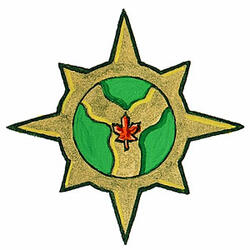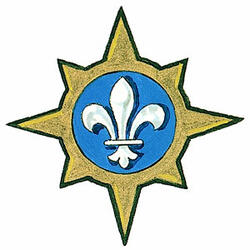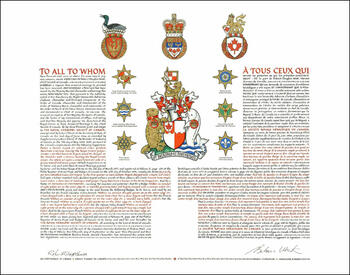The contents of this Register are intended for research purposes only. The heraldic emblems found in the Register may not be reproduced in any form or in any media without the written consent of the Canadian Heraldic Authority and/or the recipient.
Ottawa, Ontario
Grant of Supporters and Badges
September 15, 2004
Vol. IV, p. 400
Arms of The Royal Heraldry Society of CanadaBlazonQuarterly per fess embattled Gules and Argent, in the first quarter an inescutcheon Argent charged with a maple leaf Gules; SymbolismRed and white are the colours of Canada and mark the Society as a national organization. The crenellated division line indicates its mandate to stand on guard for good heraldic practice in Canada. The small shield represents the subject of heraldry itself, and the maple leaf is the national emblem. |
CrestBlazonIssuant from maple leaves Gules, a demi lion Or holding a staff proper flying therefrom a banner of the Arms fringed Or; SymbolismThe lion is a quintessential heraldic emblem, and it appears both as a supporter and as a reference to the crest of the arms of Canada. Before the original grant of arms, the Society used a lion and a maple leaf, a combination that also appeared in the armorial bearings of the Society's founding president, Alan Beddoe. The banner of the arms shows another form of heraldic display and can also refer to the sister science of vexillology, the study of flags. The maple leaves further the national symbolism. |
MottoBlazonET PATRIBUS ET POSTERITATI; SymbolismMeaning "For ancestors and posterity". |
SupportersBlazonDexter a beaver sejant Or collared Gules pendent therefrom a torteau bearing the Royal Crown proper, sinister a narwhal haurient Argent armed Or charged on the shoulder with a torteau bearing the Royal Crown proper, the whole set upon a compartment per pale of a grassy mound and waves proper; SymbolismThe supporters are recognizably Canadian animals. The beaver indicates the fur trade, which was instrumental in the development of our country; as such, it has appeared in Canadian heraldry for over 300 years. The horn of the narwhal can allude to the unicorn, a famous heraldic beast. The addition of the red discs bearing the Royal Crown indicates that the Society received permission from H.M. the Queen to include the word “Royal” in its name. |
Badge of The Royal Heraldry Society of CanadaBlazonBadge of The Royal Heraldry Society of Canada: Within an annulet of eight points set on the outer edge Or, a roundel quarterly Gules and Argent charged with a coronet erablé Or; SymbolismThe colours at the centre of the Society's badge refer to the arms design, while the maple leaf coronet refers to Canadian heraldry. The compass rose indicates Canada's northern location, the wide reach of heraldry as an art and science, and the Society's goal of setting a true course for heraldry in Canada. Each of the branch badges is framed by the same compass rose as is used by the Society, but a distinct emblem is placed at the centre. |
Badge of the British Columbia/Yukon Branch of The Royal Heraldry Society of CanadaBlazonBritish Columbia/Yukon Branch: Within an annulet of eight points set on the outer edge Or, a hurt charged with a demi sun in splendour Or issuant from a base barry wavy Argent and Azure; SymbolismThe sun and the waves allude to the provincial arms of British Columbia. |
Badge of the Prairie Branch of The Royal Heraldry Society of CanadaBlazonPrairie Branch: Within an annulet of eight points set on the outer edge Or, a roundel vairy Sable and Or; SymbolismThe vair pattern represents the skins of animals, and thus symbolizes the fur trade that stimulated the early settlement of the Canadian West. The black elements of this pattern also resemble the grain elevators that were once a common feature of the prairie landscape. The gold and black colours refer to the fields of golden wheat and to the dark prairie soil. |
Badge of the Toronto Branch of The Royal Heraldry Society of CanadaBlazonToronto Branch: Within an annulet of eight points set on the outer edge Or, a hurt charged with a rose Argent barbed Vert seeded Or; SymbolismThe white rose is the traditional emblem of York, the original name of Toronto, while the blue colour has long been associated with Toronto. |
Badge of the Ottawa Valley Branch of The Royal Heraldry Society of CanadaBlazonOttawa Valley Branch: Within an annulet of eight points set on the outer edge Or, a pomme charged with a pall wavy Or bearing a maple leaf Gules; SymbolismThe Y-shape, indicative of the coming together of the Ottawa, Rideau and Gatineau rivers, was used in the arms of the former Regional Municipality of Ottawa-Carleton. The maple leaf refers to the fact that Ottawa is the national capital. |
Badge of the Laurentian Branch of the The Royal Heraldry Society of CanadaBlazonLaurentian Branch: Within an annulet of eight points set on the outer edge Or, a hurt charged with a fleur-de-lis Argent; SymbolismThe fleur-de-lis is an ancient heraldic symbol associated with Royal France and, by extension, the Province of Quebec. |
Additional InformationCreator(s)The armorial bearings and badge of the Heraldry Society of Canada were designed in the early 1970s by a committee composed of George Beley, Thomas Pullen, Alan Beddoe, Hans Birk, Harold Diceman, Norman Nunn, Phillips Till, and Gordon Macpherson (Chairman). The designs for the Branch badges were suggested in 2003 by members of each branch. PainterGordon Macpherson CalligrapherNancy Ellis Recipient TypeCivil Institution
Other InformationOne or more entries related to this Recipient's emblems appear elsewhere in the Register: Volume II, p. 130. |

